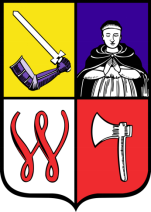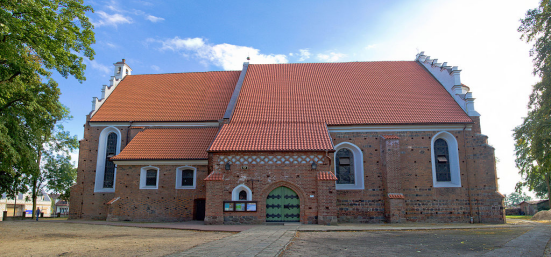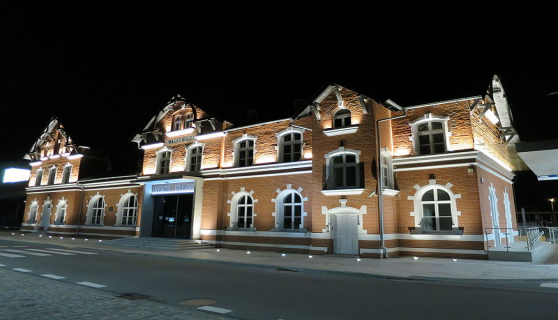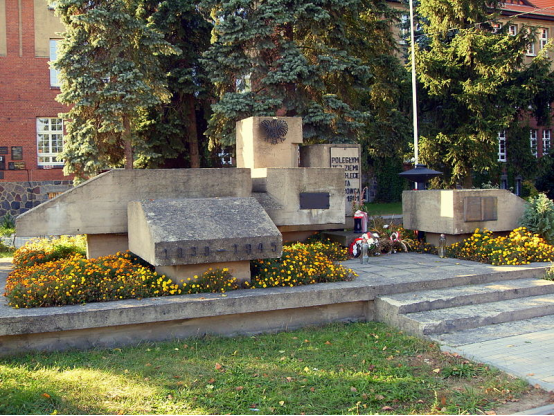Wągrowiec-Greater Poland 作者: 来源: 发布时间:2021-07-15
Ⅰ. Population and Area
Population (2006)
• Total 24,681
• Density 1,400/km2 (3,600/sq mi)
Area
• Total 17.91 km2 (6.92 sq mi)
Http://www.wagrowiec.eu

Ⅱ.Natural Geography (environment and resources)
-Wagrowiec is located in north-eastern Wielkopolska, 55 km north of Poznan and 40 km from Gniezno, 70 km from Bydgoszcz and 60 km from Pila, halfway between Warsaw and Berlin. It is the seat of Wagrowiec District. It is situated in the south of Paluki - a historic and ethnographic region with scientifically confirmed features of the oldest area of Polish settlement. Wagrowiec lies on the Cistercian Route formed in 1990 by the decision of the Council of Europe and on the Piast Route.
-Wagrowiec occupies the area of 17.9 square kilometres, including 13.8% of green areas and 8.3% of rivers and lakes.
-The region around the town is rich in lakes. The town itself sits in the middle of Lake Durowskie (jezioro durowskie). The Wągrowiec municipal area boasts a rare attraction: two rivers, the Nielba and Wełna cross there, without commingling.
-Transport
-In 2018, Wągrowiec had 21 km of bicycle paths, 0.0 km of bus lanes and 0 parking lots in the Park & Ride system. Registered 7 taxis and 7 licenses for taxis.
-Nearest Airport to Wągrowiec, Poland. Closest airport to Wągrowiec is Poznań–Ławica Airport (POZ). Distance from Poznań–Ławica Airport to Wągrowiec is 31.0 miles / 50.0 kilometers.
Ⅲ.Economy
-The sum of budget spending amounted to Wągrowiec in 2018 year 113.5 million , which gives 4.4 thousand zlotys per capita. This means an increase in expenses by 15.6% compared to 2017 . The largest part of Wągrowiec's budget - 30.1% was allocated to Department 801 - Education . A large part of the budget expenditure was allocated to Division 600 - Transport and communications ( 9.9% ) and to Division 900 - Municipal management and environmental protection ( 8.7% ). Capital expenditures accounted for PLN 19.0 million , i.e. 16.8%total expenses. Total revenue for the budget Wągrowiec was in 2018 year 104.0 million PLN, which gives 4.1 thousand zlotys per capita. This means an increase in income by 4.2% compared to 2017 . The largest part of income was generated by Department 756 - Income from legal persons, natural persons and other entities ( 39.4% ). A large part of the proceeds comes from Department 758 - Various settlements ( 22.3% ) and from Department 900 - Municipal management and environmental protection ( 4.9%). In the budget of Wągrowiec, income from personal income tax amounted to PLN 874 per capita ( 21.5% ), while income from corporate income tax was PLN 36.9 per capita ( 0.9% ). Other tax revenues, established and collected on the basis of separate acts, accounted for 14.9% .
-Więcej: https://www.polskawliczbach.pl/Wagrowiec#finanse-publiczne
-289 people work per 1,000 inhabitants in Wągrowiec. This value is comparable to the value for the Wielkopolskie Voivodeship and much more than the value for Poland. 50.4% of all employed persons are women, and 49.6% men. Registered unemployment in Wągrowiec was 4.5% in 2019 ( 6.0% among women and 3.1% among men). This is much more than the registered unemployment rate for the Wielkopolskie voivodship and much less than the registered unemployment rate for the whole of Poland. In 2018, the average gross monthly remuneration in Wągrowiec was PLN 3,912.65 , which corresponds to80.90% of the average monthly gross salary in Poland. Among the economically active inhabitants of Wągrowiec, 1,035 people go to work in other cities, and 1,011 employed people come to work from outside the commune - so the balance of arrivals and departures for work is -24 . 30.6% of economically active residents of Wągrowiec work in the agricultural sector (agriculture, forestry, hunting and fishing), 32.9% in industry and construction, and 13.0% in the service sector (trade, vehicle repair, transport, accommodation and catering , information and communication) and 1.2% works in the financial sector (financial and insurance activities, real estate market services).
-Więcej: https://www.polskawliczbach.pl/Wagrowiec#rynek-pracy
-Business presentation
-Drukuj-A A A+
-Wagrowiec has 25 thousand inhabitants. There are 3200 companies, mainly the trade and service ones, and enterprises in the furniture and metal trade. Wagrowiec is characterised by a very well developed tourist infrastructure based on the natural environmental conditions. The town plays the role of the entrepreneurship centre in the district and has numerous attractive areas, fully developed with utilities, for the service, manufacturing and recreation development.
-What is worth investing in?
-The town has approx. 70 ha of areas for investments, which are fully developed with utilities and well located along the ring road. Wagrowiec has got:
cheap areas for the location of industrial facilities,
modern telecommunication in the international automated traffic,
reserve of drinking water in the amount of 10,000 m³ a day, taken from drilled wells,
geothermal waters with temperature of approx. 80°C, located at a depth of approx. 1300m,
attractive areas for tourist investments located by the lakes,
convenient rail and road links with Poznan and Bydgoszcz,
facilities for development on a partnership basis (industrial plants, production halls, warehouses),
Qualified and relatively cheap personnel.
Ⅳ.Industrial Characteristics
-Wągrowiec is an important rail and road junction. There are several notable industries in the town, including the machinery factories (a branch of the Hipolit Cegielski factory in Poznań and a branch of the Zremb machinery factory), major food processing plants (a mill, meat canning factory and a milk yard) and a furniture factory. The town is also a centre of tourism, with several hotels along the shores of the lake.
-Key projects
1.Development Strategy for the City of Wągrowiec until 2020
2.Local Revitalization Program for the city of Wągrowiec for 2017-2025
3.The tourism product promotion strategy (SPPT) entitled "Wągrowiec as a pearl in the crown of lakes - promotion of the city's tourist values" for 2011-2018
4.Strategy for Solving Social Problems in the city of Wągrowiec in 2014-2020
5.Environmental Protection Program
6.Asbestos Removal Program
7.Study of the Conditions and Directions of Spatial Development of the City of Wągrowiec
Strategic documents and studies | The official website of the City of Wągrowiec https://www.wagrowiec.eu/pl/dla-mieszkanca/miasto/dokumenty
Ⅴ.Attrations and Cityscape

Gothic-Renaissance Saint James church

Wągrowiec train station at night

Wągrowiec train station at night
-The biggest tourist attractions of Wagrowiec are: Aquapark Wagrowiec Familijna wySPA (Family Island) - the most beautiful water and leisure park in the region, the revitalised Wagrowiec Market Square with a "dancing fountain" and the attractive natural and geographic location of the town.
-Aquapark WągrowiecThe Aquapark Wagrowiec Familijna wySPA is the most modern facility of this type in Wielkopolska, distinguished by a very rich leisure programme. The Wagrowiec water and leisure park is designed so that the whole family can spend a nice time using water attractions. Its customers have at their disposal: the recreation swimming pool, 80-m long slide, rushing river, bubble land, Jacuzzis, saunas and SPA as well as the salt cave with a graduation tower. Aquapark Wągrowiec - salt caveThe facility also features: the gymnasium, fitness club, beauty centre, massage salon, hairdressing salon, cafe and mini conference centre.
-Tourists can also admire the Market Square, beautifully revitalised in 2009, where tenements have regained their previous splendour. Among them, particular attention is attracted by the excellent facade of the pre-war "Metropol" hotel. The unique atmosphere of the Market Square is created by: the fountain dancing to the beat of the music with light effects (the only such attraction in the region), sundial, wind rose and small cafes. The "Dancing Fountain" shows are held every day at noon and at dusk from spring to autumn. The repertoire includes 10 pieces randomly changed during the shows. In winter, the fountain is covered by the dome sparkling with colours, which together with the Christmas decorations and illuminated tenements forms the charming climate of the place. The Market Square is also the place of numerous cultural, social and art events. Aquapark Wągrowiec - dancing fountain
-Ice fountainA few dozen meters away from the Market Square, on the Welna River, there is a wooden structure, which in winter turns into a unique illuminated "ice fountain". The emerging ice sculpture surprises every day with new forms carved by the Nature.
-The particular tourist attraction of Wagrowiec is also its natural and geographic location. Four lakes: Durowskie, Kobyleckie, Rgielskie and Łęgowskie, create perfect conditions for the rest and going in for water sports, including canoeing and sailing. Located in the northern outskirts of Wagrowiec, the forest and networks of promenades along the Struga, Golaniecka, Nielba and Welna Rivers and the Durowskie Lake are the favourite walks for tourists and Wagrowiec inhabitants.
-The crossing point of two rivers - Wełna i NielbaOn one of such routes, there is a unique hydrographic phenomenon - the crossing point of two rivers: Welna and Nielba (the only one in Europe and one of the two in the world). The research executed in the 1980s showed that waters of both the rivers mixed with each other at the crossing point in 10% only.
-Sport and Leisure Centre (OSiR)The tourist values are supported by the relevant tourist infrastructure - the bathing beach on the Durowskie Lake in the city centre with water equipment rental shop, six hotels and holiday centres, marinas, and sports facilities made available by the Sports and Leisure Centre (OSiR) - sports and entertainment hall with the handball court (the MKS Nielba team represents the town in the top handball league), equipped with sauna, health and beauty treatment centre, two full-size football pitches, including one with artificial grass surface, and tartan athletics track as well as the tennis courts. Hotel PietrakThe artificial field of the Wagrowiec football pitch serves as the training place for football teams from all over Poland all year long, also in winter.
-The Gothic parish church with a belfry containing Renaissance polychromies dating to (1587)
-A Baroque Cistercian monastery (late 18th century)
-Late Baroque Cistercian church (late 18th century, burnt in 1945, rebuilt in 1946-1962)
-Opatówka abbey – the former seat of the Cistercian abbots, now a regional museum
-Pyramid of Lakiński – the pyramid-shaped tomb of a Polish captain who served in Napoleon's army
-The Dębina oak tree reserve with trees more than 200 years old and up to 40 metres tall, just outside the city limits
-A 5 floor residential high-rise with a large red-white painted mast on top
Ⅵ.History and Culture
-The town was founded as a small village called Prostynie by the Cistercian monks from the monastery in Łekno in 1319. In 1381 the name of Wągrowiec is mentioned for the first time in connection with the place. By that time the town received city laws, most likely modelled after the Magdeburg Law. At the end of the 16th century, King Władysław Jagiello gave the city the privileges of market and fair, and in 1396 the Cistercian monastery was moved in.
-The town soon started to prosper. In the 15th and 16th centuries it was an important centre of trade, commerce, and manufacture (mostly textiles). This prosperity came to a halt during the Deluge, when in 1656 the town was captured, pillaged and burnt by the forces of Charles X of Sweden.
-Wągrowiec train station at night
-After the Second Partition of Poland, Wągrowiec in 1793 was annexed by the Kingdom of Prussia and was confiscated from the Cistercians in 1797. Initially a part of the newly created province of South Prussia, it was in 1807 transferred to the Duchy of Warsaw, a state allied to the Napoleonic France. After Napoleon's defeat and the Congress of Vienna in 1815, Wągrowiec was again annexed by Prussia; this time it was made a part of the autonomous Grand Duchy of Poznań.
-In 1835 the Cistercian monastic order was dissolved, and its property was confiscated by the Prussian authorities. On February 9, 1849, the autonomy of the Duchy was cancelled, and Wągrowiec — under the Germanized name of Wongrowitz—became part of the Province of Posen. In 1888 a railroad line linking Wągrowiec with Poznań was opened.
-After World War I, in 1918, Poland regained independence and Wągrowiec found itself again within its borders as part of the Republic of Poland. This did not happen without a struggle, though: in the years 1918-19 Polish inhabitants of Wągrowiec fought in the Greater Poland Uprising. The local populace had to acquire Polish citizenship or leave the country. This led to a significant decline of ethnic Germans, whose number within the district decreased from 16,309 in 1910 to 8,401 in 1926 and further to 7,143 in 1934.
-World War II memorial
-Following the Molotov–Ribbentrop Pact and the end of the invasion of Poland, which started World War II in 1939, the town was annexed by Nazi Germany. Already on September 7, 1939, German troops carried out a massacre of eight Poles in Wągrowiec. During the German occupation, Wągrowiec was part of the German Reichsgau Wartheland and its name was changed by the Nazis to Eichenbrück. Germany operated a Nazi prison in the town. Poles from various settlements of the region were imprisoned in the town, and afterwards, on December 8, 1939, the Germans carried out a massacre of 107 Poles, including activists, participants of the uprising of 1918-1919, teachers, students, farmers, merchants, in the forest near Bukowiec, north of Wągrowiec. Many Polish inhabitants were expelled to the more easterly areas of German-occupied Poland (General Government) as part of the implementation of Lebensraum policies. Wągrowiec was liberated in January 1945 and the expelled Polish inhabitants returned.
Ⅶ.Other Information
-Wągrowiec (German: Wongrowitz) is a town in west-central Poland, 50 kilometres (31 miles) from both Poznań and Bydgoszcz. Since the 18th century it has been the a seat of a powiat. Administratively it is attached to the Greater Poland Voivodeship. The town is situated in the middle of the ethnographic and historical region of Pałuki within Greater Poland and the Chodzież lake area (Pojezierze chodzieskie), on the river Wełna and its tributaries Nielba and Struga, as well as on the shores of Durów Lake.
Ⅷ.Contact Information
Mayor Jarosław Berendt
Urząd Miejski w Wągrowcu ul. Kościuszki 15a 62-100 Wągrowiec
Tel. +48 67 262-15-22
Tel. +48 67 262-03-46
Fax +48 67 262-03-25
E-mail: miasto@wagrowiec.eu
